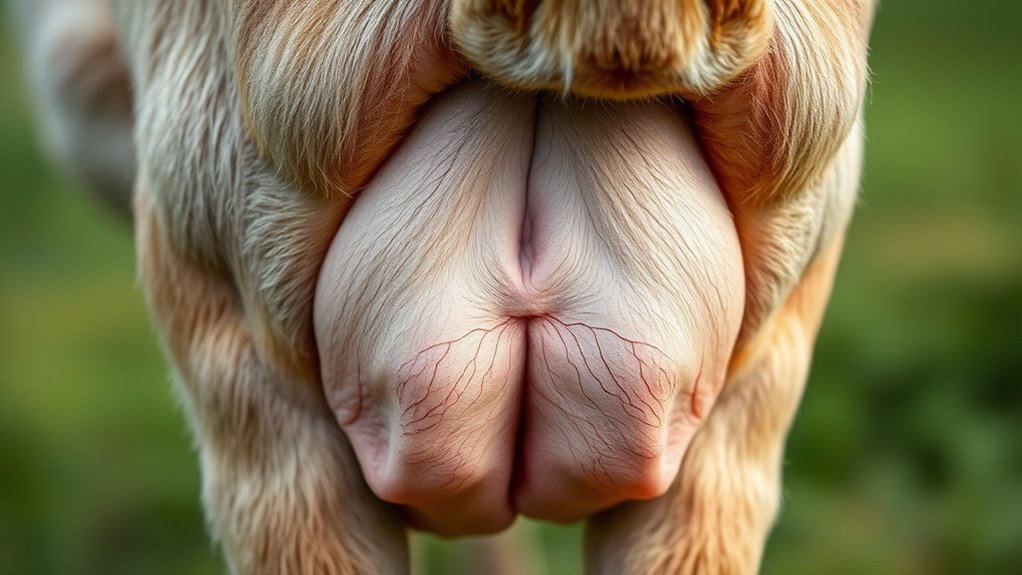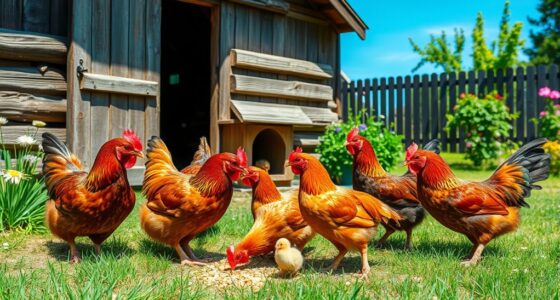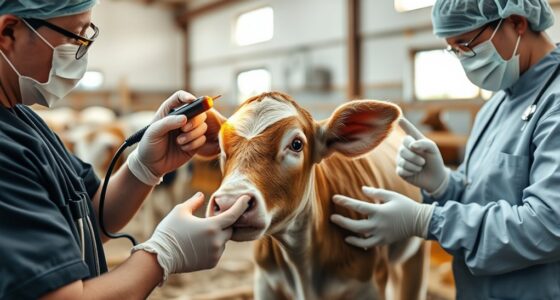During pregnancy, you should watch for significant udder volume changes, especially in the last few weeks before parturition. The udder will become tight and shiny, with teats appearing waxy. Behavioral signs like restlessness and a swollen vulva indicate labor is near. Ensure your doe has a balanced diet, plenty of fresh water, and monitor for any health issues post-delivery. There's more to explore about udder development and care throughout this process.
Key Takeaways
- Udder development begins about ten weeks before parturition, with significant growth in the final weeks of pregnancy.
- Hormonal fluctuations influence mammary gland growth, requiring monitoring for any signs of imbalances.
- A well-balanced diet, particularly high in protein and energy, is essential during late pregnancy to support udder development.
- Signs of impending labor include a tight, shiny udder and behavioral changes like restlessness and increased vocalization.
- Post-partum care is crucial; monitor udder health to prevent issues like milk fever or mastitis.
Udder Volume Changes Leading Up to Parturition
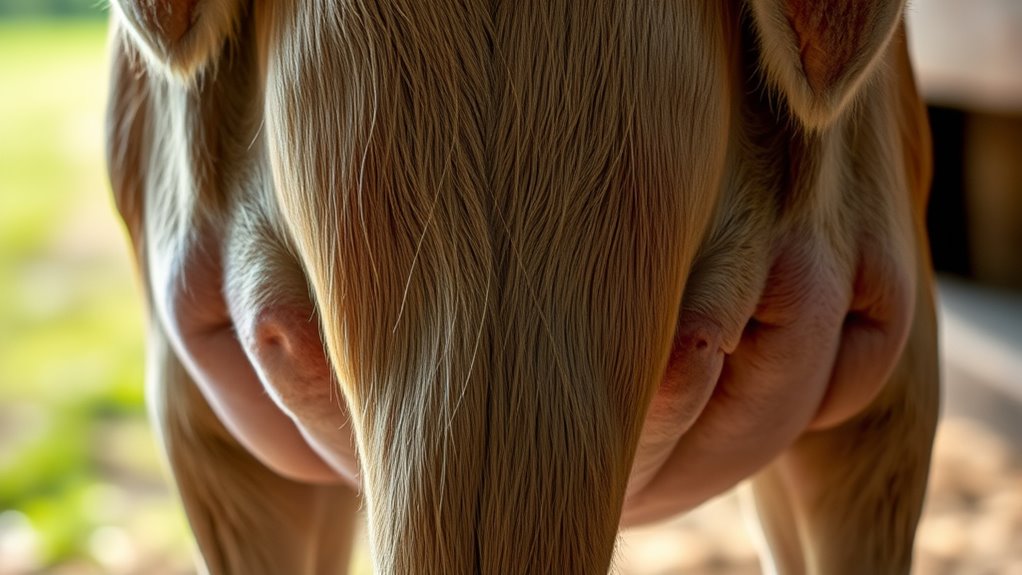
As you approach the final weeks of goat pregnancy, you'll notice significant changes in udder volume.
About ten weeks before parturition, the udder begins its initial development, with fluid transitioning to a milk-like composition.
During middle pregnancy, the udder remains relatively small, but in the last few weeks, pre-colostral fluid accumulates, leading to a noticeable increase in size.
This growth becomes exponential in the third trimester, especially during the last 50 days.
Keep in mind that udder size and growth patterns can vary by breed; for instance, Sahel does typically have larger udders compared to West African Dwarf goats.
Monitoring these changes is crucial as they signal the approach of parturition.
Hormonal Influences on Udder Development
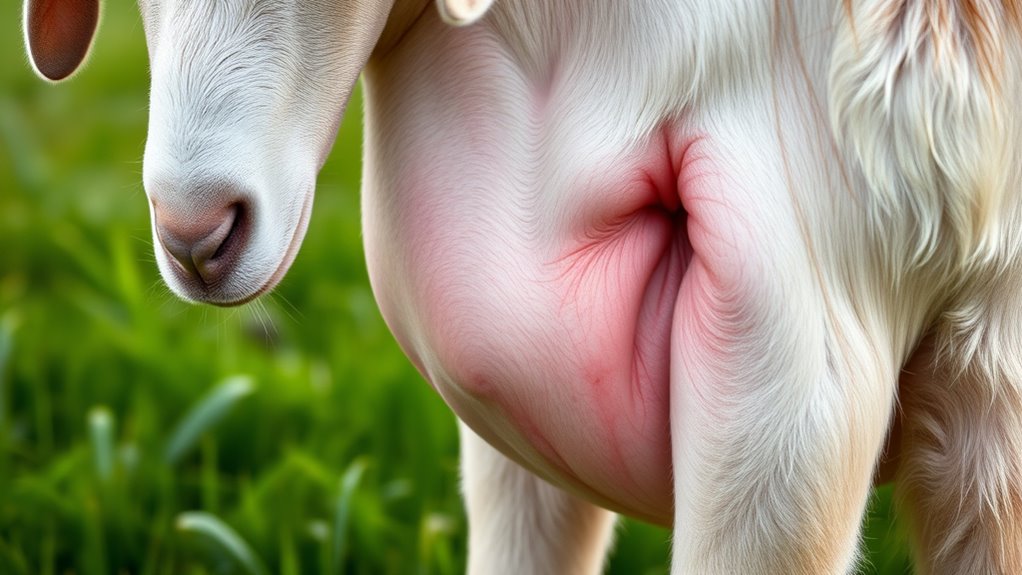
Understanding hormonal influences on udder development is essential for any goat owner, especially during pregnancy. Prolactin and growth hormone are key players in this process, promoting mammary gland growth and milk production.
As pregnancy progresses, plasma hormone concentrations fluctuate, impacting udder development and signaling cellular changes in the mammary tissue. Hormonal signals regulate the proliferation and differentiation of mammary epithelial cells, crucial for effective milk production.
However, hormonal imbalances can disrupt these processes, leading to issues in udder function. It's important to recognize that hormonal manipulation, while potentially beneficial, can also result in complications like pseudopregnancy.
Keeping an eye on these hormonal influences will help ensure your goat's reproductive and lactational health.
Nutritional Needs During Pregnancy
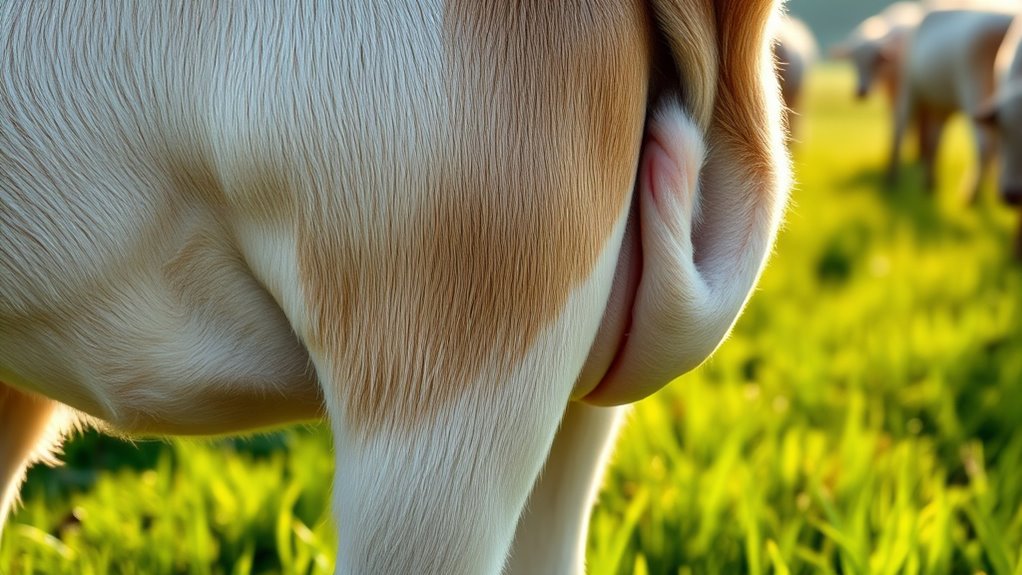
Proper nutrition is crucial for pregnant goats to ensure healthy development and successful lactation. You need to provide fresh, clean water at all times, especially during extreme temperatures.
A balanced diet rich in carbohydrates, lipids, proteins, vitamins, and minerals is essential. In late pregnancy, protein requirements increase, particularly for does carrying multiple kids. Boost their energy intake with grain and high-quality hay, like alfalfa, which offers vital calcium.
Monitor their body condition regularly, and introduce any dietary changes gradually to prevent digestive upset. Don't forget to supplement with trace minerals to avoid deficiencies. Additionally, ensure that they have access to fresh, clean water to support hydration and overall health during this critical period.
Signs of Impending Labor
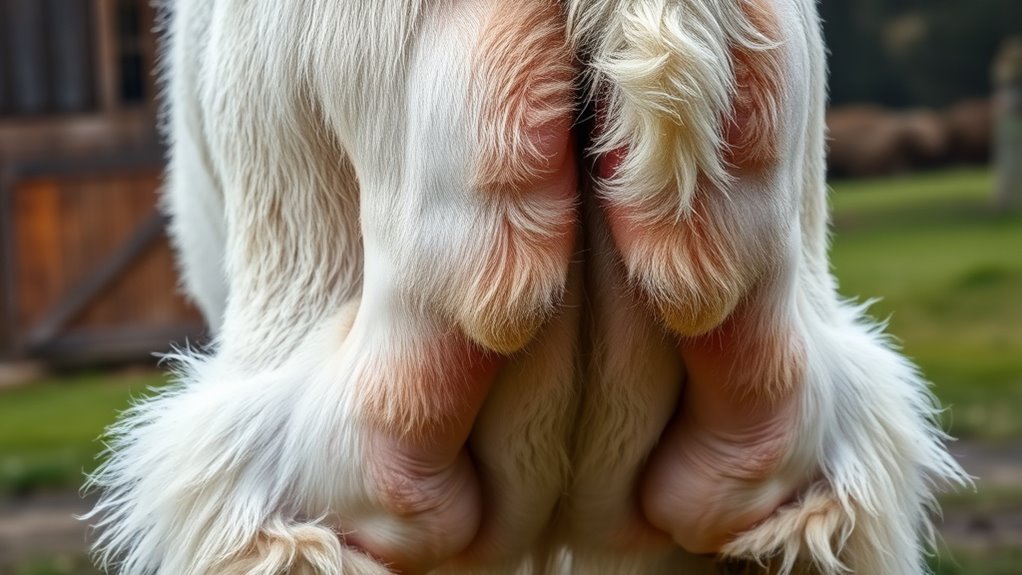
When you notice changes in your goat's udder and behavior, it often signals that labor is approaching. You'll see the udder become tight and shiny, typically 12-24 hours before delivery. The teats may look waxy and point slightly to the side.
Along with these physical signs, your doe might show behavioral changes like restlessness, increased vocalization, and a tendency to separate from the herd. You might also observe her pawing at the ground, creating a nesting area.
As labor nears, the vulva swells, and you may notice a white discharge. Keep an eye out for these signs, as they indicate your doe is preparing for the arrival of her kids.
Mammary Gland Growth Patterns

As your goat prepares for labor, you'll notice significant changes in her mammary glands. Early in pregnancy, the mammary tissue begins to develop, with adipose tissue gradually decreasing as more functional parenchyma forms.
You'll see that the growth patterns differ if it's your goat's first pregnancy compared to subsequent ones, primarily due to hormonal influences.
During late pregnancy, the rate of mammary growth accelerates, largely driven by progesterone, estrogen, and placental lactogen. You may also observe fluid accumulation in the udder, signaling preparation for milk production.
As your goat approaches labor, expect accelerated mammary growth and fluid accumulation, signaling readiness for milk production.
Keep an eye out for these changes, as they indicate your goat is nearing the time to give birth and will soon be ready for lactation.
Preparing for Lactation and Post-Partum Care
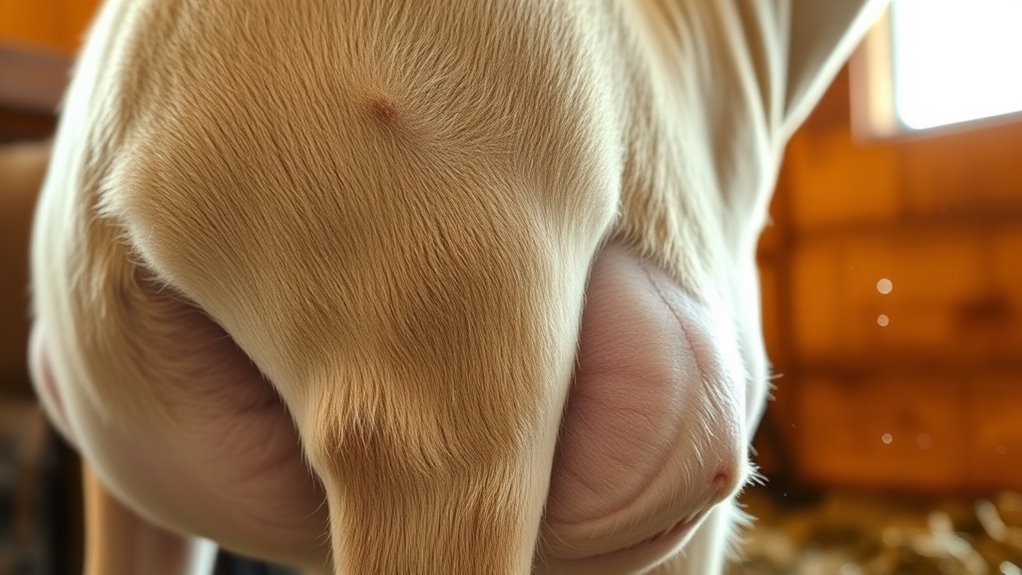
Preparing for lactation and ensuring proper post-partum care are essential steps to support your goat's health and milk production. Focus on high-quality hay, like alfalfa, to build calcium reserves during pregnancy.
Make sure she stays hydrated, as adequate water intake is crucial. Monitor her body condition, aiming for a moderate score around 3.0 to support fertility and health.
After delivery, keep a close eye on her health for issues like milk fever or mastitis. Regularly check for parasites and provide increased nutrients to support milk production.
Don't hesitate to consult a veterinarian for tailored advice. By prioritizing these practices, you'll help your goat transition smoothly into lactation and ensure she thrives during this critical period.
Frequently Asked Questions
How Can I Tell if My Goat Is Nearing Labor?
To tell if your goat's nearing labor, watch for several signs.
Look for nesting behavior, restlessness, and a noticeable discharge. You'll see her udder filling up, becoming tight and shiny, while her vulva swells and becomes flabby.
Pay attention to her behavior; she might separate from the herd and vocalize more.
Softening tail ligaments and hollow sides also indicate she's getting close.
Keep a close eye on her as the time approaches!
What Are Common Udder Problems During Pregnancy?
When it comes to your goat's udder during pregnancy, keep an eye out for a few pesky issues. You might notice some swelling, which is just a sign of your goat's body preparing for the big day.
However, watch for signs of inflammation or damage, as these can lead to infections. Maintaining cleanliness and checking regularly can help you prevent any unwelcome surprises and ensure a smooth transition into motherhood for your goat.
Can Stress Affect Udder Development in Goats?
Yes, stress can definitely affect udder development in goats.
When goats experience stress, cortisol levels rise, which may disrupt normal physiological processes, including udder growth.
You'll notice that stress can lead to poor milk synthesis and even increased somatic cell counts in their milk.
To support healthy udder development, make sure you provide a calm environment, proper nutrition, and regular health checks to keep stress levels low during critical periods.
How Often Should I Monitor My Goat's Udder?
Monitoring your goat's udder regularly is really essential.
Daily checks during late pregnancy ensure you catch any concerns quickly. Look for signs like swelling or abnormalities, as these could indicate underlying issues.
Don't forget to palpate the udder to detect any hidden health hazards.
Monthly somatic cell count tests help maintain udder health, so stay diligent!
Keeping a close watch will support your goat's overall wellness and productivity.
What Is the Ideal Temperature for Pregnant Goats?
The ideal temperature for pregnant goats falls between 10°C and 25°C.
You should monitor the Temperature-Humidity Index (THI) closely; a THI above 77 indicates medium heat stress, while anything above 85 signals extreme heat stress.
To ensure your goats remain comfortable, provide adequate shelter and ventilation, and keep fresh, cool water available.
Conclusion
In conclusion, keeping a close eye on your goat's udder health during pregnancy isn't just important—it's essential. As you monitor changes in volume, hormonal shifts, and nutritional needs, you'll be better prepared for the miracle of life. Remember, the signs of impending labor can be subtle, but with attentive care, you'll ensure a smooth transition into lactation. After all, a well-cared-for goat not only thrives but also enriches the entire farm with her nurturing presence.

